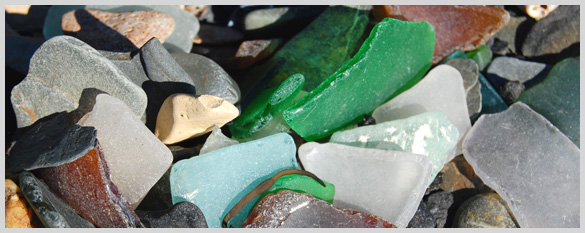
Photograph by Virginia L. Thorndike.
There's an old dump on the beach of one of the many many islands off the coast of Maine. Everywhere there is evidence remaining of its earlier function: in the intertidal area there is nearly as much glass as rock, sea-washed glass in uncountable colors. I imagine many islands have similar beaches.
Standing on this one and looking to the sea, you're facing south and east and looking across islands of all sizes. It has been more than 70 years since the islanders stopped leaving their refuse on this beach, during which time the morning sun has warmed it and afternoon sou'westers and nasty southeast storms alike have sent the waves onto it.
The sea glass comes in recognizable shades -- old-Coke-bottle aqua in soft and inimitable curves, Canada Dry ginger ale green, and Noxema blue -- not much of that, as the beach has been too much picked, over the years. There are pieces of the very light lilac that some very old clear glass turns as it ages, greens in a hundred shades, clear chunks softened to a white surface and thinner clear sections, and beer bottle brown along with other browns both lighter and darker. Sometimes lettering stands out, identifying companies both extant and long-gone: a single piece of a clear Gordon's gin bottle, and myriad Cantrell something-or-other, in green.
Each glass shape has its own feel. Some are entirely rounded and smooth while others have kept a sharp edge or recently broken to one; some have pebbled surfaces or logos. Some are recognizable: bottoms and necks of bottles, sections of Mason jar lids. Some are shaped amorphously, broken at random angles with bends and twists that hide the original form. Some look as if they have settled with time; I saw one former bottle-neck melted around a pebble, clearly visible today enfolded in glass. They say glass is a liquid.
Driftwood tree trunks lie along the top of the beach; visitors sit on them and admire the sea and the breaks of rock and tree that interrupt it. And invariably, there is glass lined up along a flat place on the wood, arranged perhaps by a child as bright examples of each color, or, as I have done myself a time or two, in a long line graduated subtly by shade, from clear to the darkest of one hue. You could never find a sample of every green the beach offers, though. You think you've done it, your spectrum of just this one color is complete, and then your eye catches yet another shade.
Each of these remnants was a part of an object once, made by someone, used for something, tossed aside by another person. Did this particular shard store pickles made from island cucumbers? Or did it merely provide a transporting mechanism for a product “From Away,” that was simply consumed on the island? Was it purely decorative? A vase, maybe? Was it broken and thrown away, or thrown away intact, and broken by the beach? Was it then treasured as it is now?
Beach glass is collected by nearly every beach-wanderer and kept for itself or turned into
objets d'art, corny or beautiful or both. I have always been a beach glass collector, and have Band-Aid boxes and wooden containers dating back to childhood each with a few glass treasures within, but on this glass beach I feel compelled to leave each piece behind.
I wish others had done the same.
 Photograph by Virginia L. Thorndike.
Photograph by Virginia L. Thorndike. Photograph by Virginia L. Thorndike.
Photograph by Virginia L. Thorndike. Photograph by Virginia L. Thorndike.
Photograph by Virginia L. Thorndike.